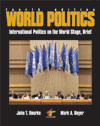Thre are few stories better than that of the sad fate of the Aral Sea to illustrate humankind's abuse of the environment and its devastating consequences. The inland sea is located between Kazakhstan to the north and Uzbekistan to the south. In 1960, when those countries were still part of the Soviet Union, the sea was the fourth largest inland body of water, covering 26,300 square miles, an area about the size of Belgium and the Netherlands combined. Then, beginning in the 1960s, Soviet agriculture demands and horrendous planning began to drain water from the sea and from the two great rivers that feed it (the Amu Darya from the north and the Syr Darya from the south) faster than the water could be replenished. The sea started to shrink rapidly. As it did, the level of its salinity rose, and by 1977 the catch from the once-important fishery had declined by over 75 percent. Still the water level continued to fall, as the sea provided irrigation for cotton fields and for other agricultural production. The same Soviet planning that brought the world the Chernobyl nuclear plant disaster in Ukraine, stood by paralyzed as the Aral Sea began to disappear before the world's eyes. Now, in reality, geographical name Aral Sea is a fiction, because it has shrunk in size and depth so much that a land bridge separates the so-called Greater Sea to the north from the Lesser Sea to the South. What was a single sea has lost 75 percent of its water and 50 percent of its surface area in the past 40 years. That is roughly equivalent to draining Lake Erie and Lake Ontario. The Uzbek town of Munak was once the Aral Sea's leading port, with its fishermen harvesting the sea's abundant catch. Now there are few fish, but even if there were many, it would not help the people of Munak. The town is now in the middle of a desert; the shoreline of the Lesser Sea is 50 miles away. |



 2002 McGraw-Hill Higher Education
2002 McGraw-Hill Higher Education